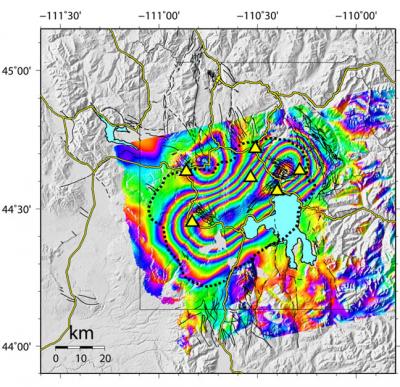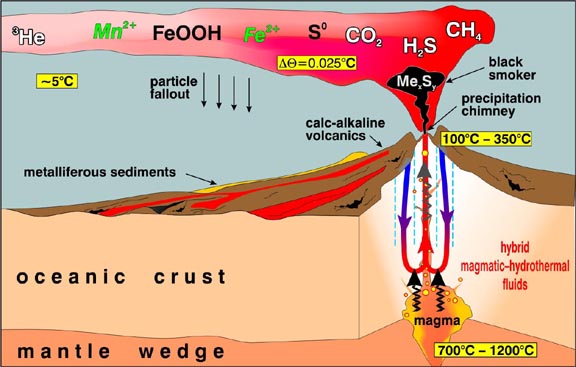- Current models explaining the swelling of a volcano before eruption point to explanations involving an expansion of the magma chamber and an increase in magma volume
- Simple calculations presented here show that thermal expansion alone is quite sufficient to explain the swelling
- There seems to be a reluctance amongst geologists to consider thermal expansion as a potential driver in geological processes.
A few weeks ago I heard another program about a volcano which talked about the swelling of a volcano before an eruption (as shown on image below). What interested me was the reason they gave for this swelling: an increase in magma in the chamber beneath the volcano. I’d like to suggest a far more plausible mechanism. First however what does it look like:
The measurements can be made not only by satellite as shown above but also a number of other techniques:
Ground deformation (swelling, subsidence, or cracking) is measured with a variety of techniques, including Electronic Distance Meters (EDM), the Global Positioning System (GPS), precise leveling surveys, strainmeters, and tiltmeters. EDMs use lasers to accurately measure changes in distance between benchmarks (fixed points) with repeated measurements. GPS makes use of satellites orbiting the Earth to determine and track the locations of points. Strainmeters and tiltmeters are used to monitor subtle changes in shape of the ground surface. For more information, please see Monitoring Volcano Ground Deformation in our Activity Section. (link)
And the ground swelling is associated with other effects:
“These signs may include very small earthquakes beneath the volcano, slight inflation, or swelling, of the volcano and increased emission of heat and gas from vents on the volcano,” said U.S. Geological Survey (USGS) Volcano Hazards Program coordinator John Eichelberger. (link)
But what do geologists think causes this movement? The descriptions imply that a volume of magma moves into a chamber and it is this volume change that causes the upswelling:
Once the GPS and InSAR data reveal a pattern of ground movement, scientists try to re-create similar patterns using mathematical models. This allows them to estimate possible depths and volumes of the deformation source. Scientists agree that a fluid has moved into the region, causing an increase in volume within the upper 15 km of the crust. Wicks et al. (2006) propose the idea that a small amount of basaltic magma (molten rock) has moved out of the main caldera (causing the ground to subside) and into the area north of the caldera (causing the ground to move upwards). They discern that the magma moved along a northward-dipping sill (sub-horizontal crack) located about 12-15 km beneath the ground surface. In the past, some scientists have preferred models where deformation at Yellowstone is caused by movement of hydrothermal fluid (hot water) or gas, rather than magma. For example, Waite et al. (2002) discussed a swarm of earthquakes that occurred in the western part of the caldera, that coincided with a change from uplift to subsidence in the caldera. They suggested the swarm was caused by movement of hydrothermal fluids (hot waters and gases) from inside the caldera to the northwest. Both types of fluids (magmatic and hydrothermal) may occasionally cause the observed deformation at Yellowstone. Scientists will continue to collect information that can help discriminate among the various possibilities.
However, I have very severe doubts about this kind of explanation. For a start, order to “pump up” the ground there needs to be a source of energy. And if as is implied by the above this is delivered as a change in pressure, then something must be driving the pressure. But since all the magma (at the same pressure) is the same density, unless you start talking about temperature change, you are resorting to mechanisms involving a replacement of one type of magma at one density with another at another.
Temperature
So, I’d like to suggest a much simpler explanation. That explanation is that there is no change in the volume of magma – instead all that happens is that cooler magma is replaced by hotter magma – it then heats the overlying rock – and that it is this heating that causes the expansion, not of the magma chamber itself but of the overlying rock.
So let’s see what temperature change is needed. Here’s a nice example:
Using 19 temporary and five permanent GPS stations, researcher Andrew Newman has been monitoring the expanding deformation of Santorini that began on January 21, 2012. Over six months, the surface of the volcano has expanded by 140 mm at a rate of 180 mm/yr due to a relatively stable magma source located at four km depth that has expanded by 14 million cubic meters. (link)
Let’s assume the rock is basalt Granite with a thermal expansion of .0000085/C . Thus the temperature change across 4km of rock to expand by 140mm is:
C = 140(mm) /( 4000000 (mm) * .0000085)
C = 4C
A change of just 4C in the average temperature of the 4km of rock beneath the volcano will lead to around 140mm of expansion! Let’s turn this around. What length of rock needs heating to the temperature of magma to obtain the expansion? I read magma has a temperature of between 700C and 1300C. Let’s assume we have a change the magma from the coolest to warmest in that range = 600C. Now:
Distance (mm) = 140 (mm) /(600 * .0000085)
Distance = 2.75 m
And yes! That is meters. Not 3km of expansion not 300m but 3m. This shows that even a very small amount of rock, heated by magma could explain the 140mm expansion seen under a volcano.
A new model
Above is a diagram showing a volcano with its associated gases. Whatever is key, is the flow of heat as indicated by the flow of sea water in the above diagram. All we need to have to explain the swelling of a volcano, is an increase in the temperature of this flow and the consequential heating of the rock beneath the volcano. There is no need to explain anything via an “increase in size of the magma chamber” as seems to be the current model. There is no change in the pressure of the magma in the chamber – it is not the magma “blowing up” that pushes out the rock, it is the surrounding solid rock, being heated that then swells.
I’m not saying there is no change in magma, instead that thermal expansion alone is sufficient to explain all the expansion. Indeed, if I use the figures above, then for a 100C rise in temperature (which could be due to hot water alone) would only need to heat 160m of rock beneath the volcano.
A Model of a Volcanic Eruption
What I suggest may happen, is that for some reason lighter magma (perhaps with gas entrained) makes its way under a volcano. That magma then convects up beneath the volcano raising the temperature of the magma underneath the volcano, which in turn heats the rocks, causing swelling, rock movement, volcanoes and cracking. That cracking in turn creates fissures which allows magma or water to transfer more of the heat upwards causing further expansion, fissuring etc.
In some instances, the heat is eventually dissipated and stability restored. But occasionally, we get a runaway process whereby more and more heat is moved toward the surface via fissures, magma then follows causing further heating, that heating increases the rate of fissure production and widening of fissures, further increasing the rate of magma flow and heating … and we get a runaway process leading eventually to the explosive release of air-entrained magma at the surface aka “a Volcanic eruption”.
Comment
There does seem a reluctance in geology to accept that rocks when heated expand. It’s almost as if they’ve never heard that rock expands. I saw this first when presenting the Caterpillar effect which shows that the temperature change over an ice-age cycle will cause expansion (over land) comparable in scale to “normal” plate tectonic movement (a few mms per year).
Now, I’ve very quickly shown that given the very large temperature changes associated with magma, that relatively little rock needs to change in temperature to explain the swelling seen before volcanic eruptions. But again thermal expansion appears to be ignored, and instead the prevailing concept appears to be that the magma chamber is “blowing up like balloon”, when there is no obvious mechanism to supply the energy to cause the necessary pressure to create that “blowing up” effect of the magma chamber.




http://onlinelibrary.wiley.com/doi/10.1029/2006GL028101/abstract
Ground deformation due to magma ascent with and without degassing
Takeshi Nishimura
I numerically calculate upward migration of vesiculated magma in an elastic volcanic conduit, taking into account the bubble growth in melt, elastic stress from the surrounding medium, and degassing from the magma. The results show that when magma containing gas bubbles reaches the ground surface without degassing, the ground deformation accelerates just before the eruption in response to volumetric expansion of the magma. On the other hand, the rate of change in ground deformation is almost constant when the magma degasses as it ascends. Similar characteristics have been observed in ground deformation recorded before explosive eruptions and lava extrusion at several active volcanoes. These consistencies strongly suggest that geodetic measurements, which have been mainly used to date to estimate the eruption time and the locations of magmatic intrusions, provide a basis for predicting the volcanic explosivity and monitoring bubble growth and degassing processes in the conduit.
Thanks interesting – yet even in this paper there appears to be no discussion or mention of anything descending. The model I’m proposing would be a magma “circulation” – whereas the model these propose is a “magma dead-end”. Which makes me wonder what they think was in the space the magma fills before it enters and what happens to it?
In a circulation model, the magma brings in heat (and I would suggest it is driven by gaseous flows and density changes). But unless it’s too mickey mouse for the paper to explain, I can’t see how the model of “rising magma” works. Is there supposedly a hollow void under the earth? Does the magma come in and inflate the earth like someone blowing up a balloon? Is the hollow filled with water or other material that is pushed out as gas? If however, it’s an incompressible rock – then it’s got to go somewhere.